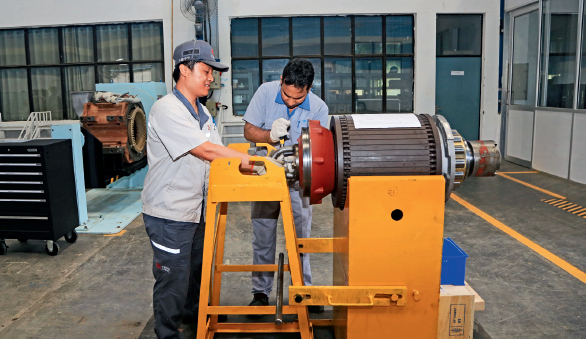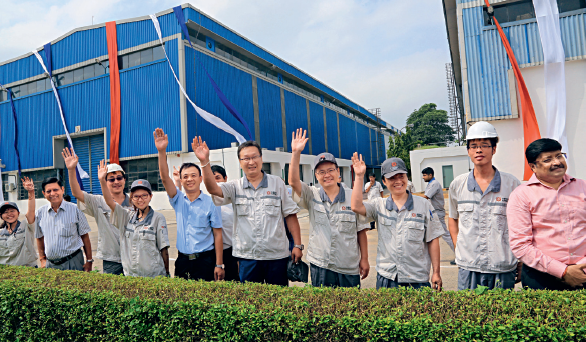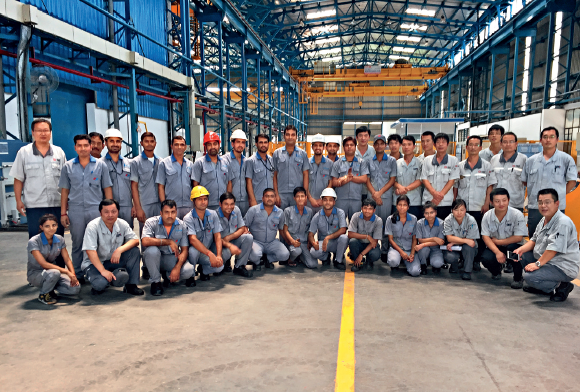A Chinese Brand Takes Root in India
China Today by Wang Juan, October 13, 2016 Adjust font size:
Hard Beginnings
Diesel locomotives still dominate India’s railways. As the old Chinese saying goes, “A train’s speed totally depends on its locomotive.” Traction motors are the power source of locomotives on which a train’s speed and load limit depend. Thererefore, this motor is the “heart of the locomotive.”

A CRRC Yongji technician gives guidance to a local employee at CRRC’s Indian plant.
However, CRRC Yongji Electric Co., Ltd.’s presence in India’s train motor market has not been a smooth process. Since 2007, when its products first came to India, CRRC Yongji has supplied India’s Ministry of Railways with a range of motors, generally main-generators and traction motors for major types of locomotives. Owing to reliable quality and excellent services, CRRC Yongji has become a Part I supplier of India’s MOR, providing growing numbers of motors for India’s locomotives.
Recalling the early days after the first batch of CRRC-produced motors arrived in India, Yu Weiping spoke of the venture’s hard beginnings. “Our motors, and three of a U.S. brand, were tested on the same locomotive. On the first day, there was a technical problem. This displeased the chief Indian designer and also surprised me,” Yu said. Later, CRRC Yongji’s engineers pinpointed a problem with the American motors, and made suggestions as to solving it. They thus gained the trust of their Indian client.
Another challenge came in March 2013 when CRRC Yongji completed trial production for their Indian client Diesel Locomotive Works of main and accessory generator samples. While comparing notes about the acceptance check, a divergence occurred between the two sides about generator efficiency calculations. CRRC Yongji technicians patiently but firmly stood their ground on the basis of scientific and detailed calculations, and so passed the stringent acceptance check.

CRRC Yongji technical support personnel at the formal ceremony marking the start of the joint venture’s regular operations.
Despite these incessant challenges, Party secretary of CRRC Yongji Ning Wenze showed firm resolve in pushing forward the enterprise’s “going global” strategy. “Blazing a trail for overseas operations is essential if CRRC Yongji is to become a competitive supplier of electrical driving system solutions and serve global clients. Realizing internationalization is an inevitable step for Yongji.” Consequently, the company values each challenge, regarding it as priceless experience in exploring the international market. Each encounter in the Indian market acts as a touchstone for CRRC Yongji’s global operations.
“Establishing a joint venture overseas entails numerous problems and tasks. Differences in culture and working habits are often the biggest hindrance,” CRRC Pioneer (India) Electric General Manager Jing Yuepeng said. CRRC Yongji’s patience and perseverance has paid off.
To make China’s advanced electric transmission technology benefit more Indian residents, CRRC Yongji has proactively responded to the Indian government’s “Make in India” initiative by seeking local cooperation partners. After comprehensive investigation and research, Yongji decided to realize “Make in India” by setting up a joint venture. The company employed local residents and equipped them with professional expertise. Such localized production can lower costs and create jobs. Meanwhile China’s railway industry exports have expanded from equipment to technology, capital, and services. In addition to products, Chinese operations and brands are also going global.

CRRC Yongji technical support personnel and local employees at the CRRC’s Indian plant.
CRRC Pioneer (India) Electric Co., Ltd. was founded in 2014 with a total investment of US $63.4 million, of which CRRC Yongji holds 51 percent and India Pioneer 49 percent. The joint venture’s main business is providing technical support to the Indian railway sector, and also supplying electric transmission systems to India’s oil drilling, wind power generation, and mining equipment making sectors. The first India-made motor having successfully rolled off the plant’s production line, Indian railway locomotives are expected to be equipped with more and more locally produced, world advanced “hearts.”
CRRC Pioneer (India) Electric Co., Ltd. is located in the Bavo Industrial District of Haryana between New Delhi and Bombay. The state is spanned by part of the Modi government-conceived high-speed railway network. CRRC Yongji seeks to expand its business fields through advanced electric transmission technology and a steady supply of quality products. This will boost development of India’s high-speed railway related industry. As of now, CRRC has received orders for around 300 subway trains earmarked for subways in Delhi, Bombay, and Calcutta.

